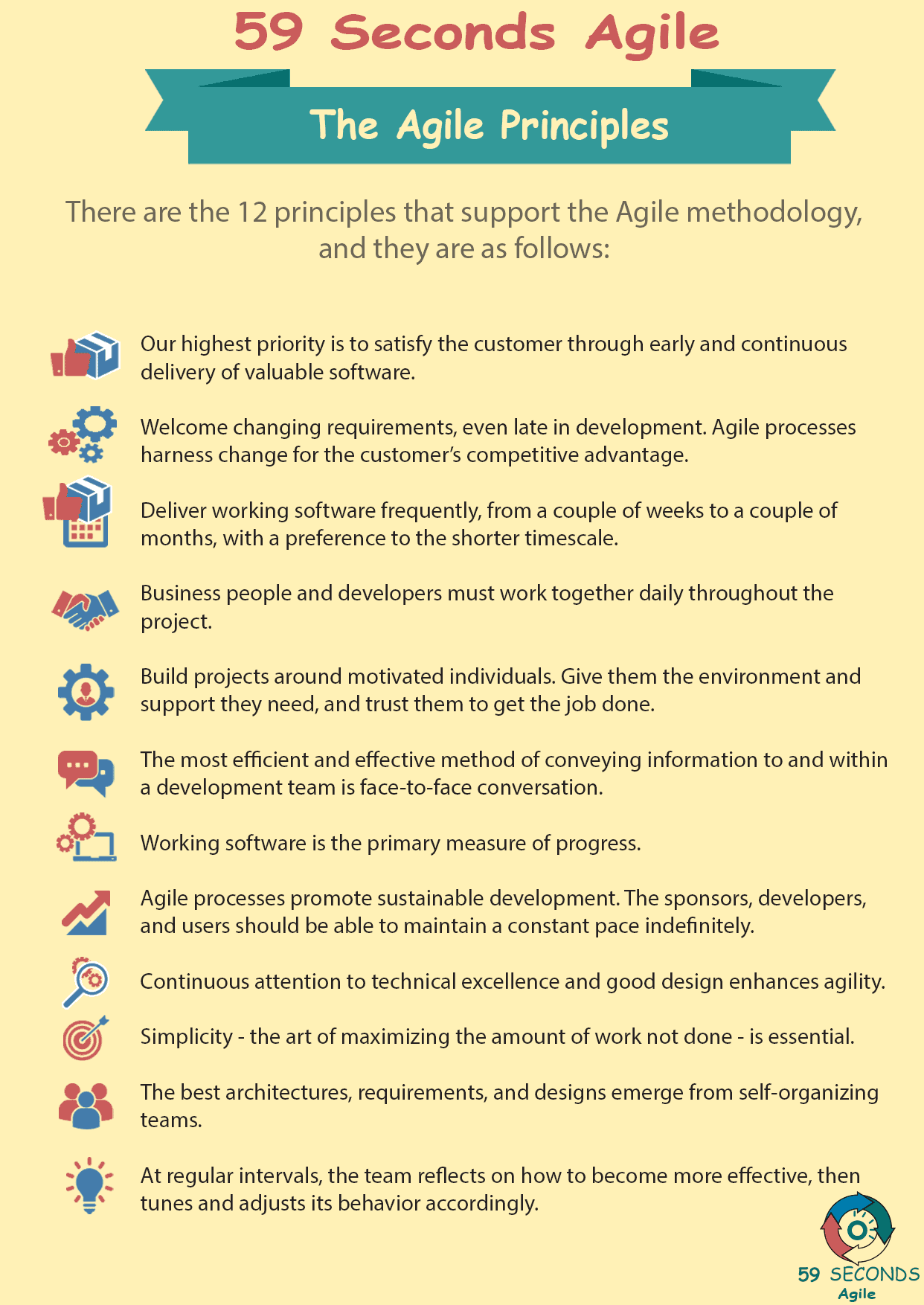The Twelve Agile Principles
A 59 Seconds Agile Training Video
Continue to Part 17 Below
The Twelve Agile Principles
A 59 Seconds Agile Article
This article provides an ‘Introduction to the The Twelve Agile Principles‘ and looks to discuss what each or the principles are and what each principle means.
How the Principles Add Value to a Project
The agile principles put more tools in your toolbox to handle the varied obstacles that come up in any project. Here are some of the benefits of applying the Agile principles: One, speed to deliver and minimising risk
Traditionally, businesses have given their requirements to their development team and then wait to see the result. Some projects took years, going over time and budget in the process. Then what was delivered was out-of-date and inappropriate for the business, because the business and its requirements had changed direction or been faced with new challenges during the time it took to deliver the product.
Agile development seeks to change this waste of time and money by principles 1,2,3 and 4. Rapid delivery and the willingness to accept change mid-stream reduces requirement risk. Value 4, “Responding to change” is both acknowledged and applied by agile development.
Two, managing customer expectations. Principles 2,4,6, and 10 speak to assuring a good customer experience. The need for customers to be intimately involved in the development of the new product will both keep the development team on track and highlight the possible need for any changes as early as possible. These principles support the third Value “Customer Collaboration“.
Three, deliver what is needed. Traditional projects that overran typically were loaded with features that were not critical or even necessary. Therefore, design thinking and the identification of a minimum viable product before the project commences is critical. Principle 10 – “simplicity” promotes a minimum viable product.
Four, enable the development team. The development team is autonomous and democratic. It is the team members who decide how the team works, not a manager. Enabling a team is all about trust. The result of such enablement results in optimal design where project members are given the freedom to work as a team.
Five, freedom is not given at the cost of quality. In Principle 7, the important word is “working“. It does not help to deliver buggy product quickly. Principle 1 also describes “valuable” software. The second Value is “working software“. Principles 9 and 11 speak of technical excellence, while principle 12 calls on the team to introspect regularly to improve the way they work. This will help developers to maintain pace and sustainability over the long run.
Six, human-to-human over electronic communication. Regular interactions between customer and developer, developer and developer and any other stakeholders is emphasised. Principles 4, 6 and 12 address the need for communication, and that it should be face-to-face. This is also expressed in the first Value “Individuals and interactions“. Regular and frequent communication will keep the project on track, spot potential glitches and keep everyone informed. Principle 12 also indicates that there is a time and place for meetings in the project, such as the four “ceremonies” of Scrum.
Continue Reading —> Next
The Agile Principles
A 59 Seconds Agile Video Animation
Continue Reading —> Next
User Stories Applied
A 59 Seconds Agile Book Review
User Stories Applied by Mike Cohn is one of our favourite books on Agile User Stories. The book starts with an overview into user stories, and details what a user story is and the different aspects of them. He then discusses how to go about writing a user story, and provides details of the INVEST criteria that can be used to determine if the story is meeting all of its objectives. Next Mike gives an in depth discussion of who user stories are written for and where to begin when gathering the details for them. The book then discusses acceptance testing user stories, including how to go about specifying these criteria and the responsibilities of the development team and customers during this process.
Continue Reading —> Next
The Agile Principles
A 59 Seconds Agile Infographic

Continue Reading —> Next
Agile Scrum Master Training Course
Our Favourite Agile Books
We found these books great for finding out more information on Agile Scrum:
Continue Reading —> Next


